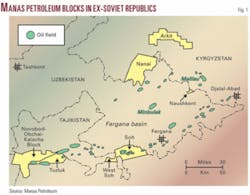Operators are shooting 1,500 line-km of 2D seismic surveys in the Fergana basin in Kyrgyzstan and starting some of the first drilling in the basin since Soviet times.
A seismic program operated by a unit of Santos Ltd. of Australia involves 849 km on licenses under tenure to CJSC South Petroleum Co. (SPC) and 689 km on licenses held by CJSC Textonic, both headquartered in Bishkek.
SPC is owned 70% by Santos International Holdings Pty. Ltd., 25% by DWM Petroleum AG, and 5% by Kyrgyzneftegas. Manas Petroleum Corp., Baar, Switzerland, owns DWM. Tectonic is legally owned by Caspian Oil & Gas Ltd., Balcatta, Western Australia, and beneficially owned 33% by Santos and funded by Santos as part of farmouts from SPC and Textonic.
Acquisition has begun in the Tuzluk (SPC) and Sulukta (Textonic) licenses and is to continue in SPC’s West Soh, Soh, Naushkent, and Nanai licenses and Textonic’s Katran, Akbura, Charvak, East Mailisu, and West Mailisu licenses.
The $10 million-plus program is likely to take 12 months. If results are positive, drilling could take place in 2008 or later. Acquisition contractors are OJSC Saratovneftegeofisica and OJSC Kyrgyzgeofisica.
Kyrgyz drilling
Separate from the joint venture with Santos, Caspian Oil & Gas appears to have extended Mailisu III oil field to the northwest at the first of 11 planned wells in the northern Fergana basin.
COG’s Mailisu III-2 well was to spud on Nov. 9 toward a projected 1,500 m with oil targets in the Paleogene and gas targets in the Jurassic.
At Mailisu III-1, close to the southern boundary of the company’s Ashvaz license, oil saturated cores and wireline logs suggest that the well cut as much as 2 m of net pay in the Bed V and VII intervals, which will be pump-tested.
The Mailisu III license has oil reserves of 6 million bbl, of which 1 million bbl have been produced, the US Geological Survey estimated in its 1994 report on the Fergana basin.
COG’s drilling program has four focus areas: Mailisu III/Ashvaz, East Mailisu, North Charvak, and Charvak, all clustered northwest of Jalal-Abad. Reprocessing of seismic by Santos has identified further leads with potential at less than 1,000 m on the Charvak and East Mailisu blocks that will be followed up later.
COG is using a new rig purchased from China with a depth capacity of 2,500 m or more.
Fergana objectives
The Fergana basin has been producing oil and gas since 1902, Manas Petroleum noted.
Discovered reserves total 1.2 billion bbl and 5.5 tcf of gas, and cumulative production exceeds 600 million bbl.
The basin lies on an oil trend between the Precaspian basin in northwestern Kazakhstan and northwestern China’s Tarim basin. Fergana and Tarim share the same geology.
Working with the Kyrgyz state oil company Kyrgyzneftegaz, a Manas shareholder, has acquired what it views as the best lands in the basin (see map).
Manas said the collapse of the Soviet Union in 1991 ended Soviet exploration and discovery of large oil fields in the basin’s deeper underthrust structures, but China continued drilling the same types of deep structures, resulting in the discovery of more than 15 billion bbl of oil.
The USGS noted that the oil should be contained in structures similar to Minbulak, the type outlined on the Manas’ concessions (OGJ, Aug. 6, 2007, p. 36). The primary reservoir is multiple layers of thick Paleogene and Neogene sandstones.
Minbulak field, 50 km from the Naushkent and Nanai licenses, produced thousands of barrels a day per well from Neogene sandstone under high pressure at 17,000 ft (OGJ, Apr. 27, 1992, p. 25).

